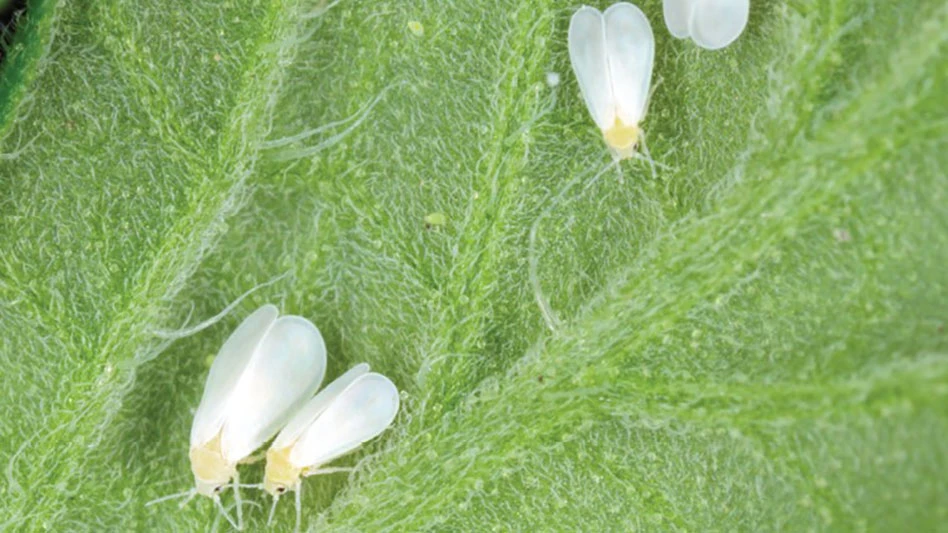

1. Aphids
Aphids are small, soft-bodied insects that cluster in colonies on leaves and stems. They are sucking insects that insert their beaks into a leaf or stem to extract plant sap. In general, they prefer to feed on tender, young growth.
They can cause leaves or stems to curl or pucker and they leave behind “honeydew.” Ants, which feed on honeydew, are often found in association with aphid infestations. Black sooty mold often develops on leaves with honeydew.

2. Whiteflies
Whiteflies have powdery white wings and are about 1/12 inch long. They feed on plant sap and flutter from the undersides of leaves when plants are disturbed. The lower surface of the leaves may be infested with all life stages of whiteflies.
Their entire life cycle takes about three weeks, allowing populations to build quickly.
Infestations cause plants to yellow and lose their leaves prematurely, and produce large amounts of honeydew, which in turn is colonized by black sooty mold.

3. Fungus gnats
The larvae of some fungus gnat species will feed on root hairs, enter the roots or even attack the crown or stem of the plant. Plants infested with fungus gnats generally lack vigor and may begin to wilt. Fungus gnats are 1/8-inch black flies with long legs and antennae, tiny heads and one pair of clear wings. Females lay tiny ribbons of yellowish-white eggs in growing media.

4. Mites
Mites are sap-sucking pests which attack a wide range of greenhouse plants. The two-spotted spider mite can cause serious and persistent problems. They are light to dark green with two distinctive black spots on the abdomen. They feed on the undersides of leaves, giving the upper leaf surface a mottled appearance. Leaves may turn yellow and dry up, and plants may lose vigor and die when infestations are severe. Mites can easily be moved to infested plants on clothing.

5. Thrips
Thrips are tiny and have four featherlike wings, each consisting of a thick supporting strut with fine hairs on the front and hind edges. Thrips may feed on leaves, flower buds, flowers, or fruit, depending on the species. Damage includes discoloration, distortion, premature drying, and shedding of leaves, flowers and buds. Thrips populations generally peak during spring and early summer.

6. Mealybugs
Mealybugs have wool-like bodies that are distinctly segmented and are usually covered in wax. Adult female mealybugs are wingless. The males are rarely spotted but are two-winged and have two long tail filaments. They range in size from 1/20 to 1/5 of an inch. By sucking sap from plant phloem, they can reduce plant growth, cause leaf drop and branch dieback. Black sooty mold grows on the honeydew and wax they excrete.

7. Scale
Scales can be categorized as either soft or armored. Female soft scales lack any recognizable body parts and are grey, brown or black and smooth and measure 1/4 inch in diameter. Brown soft scales are oval and flattened and pale in color with a grid-like pattern. Scales feed by sucking plant sap, and some scales inject toxins as they feed, further compounding the damage. Yellowed leaves and distorted foliage are indications of scale infestations. With soft scale infestations, honeydew and sooty mold are also present.

8. Caterpillars
Caterpillars feed on plant leaves and flowers. Adults feed on pollen and nectar. Some caterpillars roll plant leaves together in a silken web, others tunnel into stems and buds, and some are active at night cutting off plants at their base. They are voracious feeders and can severely damage plants. They leave frass on damaged plant leaves. Visually inspect plants when moth or butterfly adults are active. In greenhouses, pay close attention to susceptible plants near doors, vents and other openings.

9. Leafminers
Leafminers are larvae of small flies. They damage plants by feeding between the upper and lower surface of the leaf. Damaged areas are light in color and narrow and winding. When fully grown, the larva may pupate in the leaf tissue or emerge from the leaf and fall to the ground to pupate. Females insert eggs into pits made in the leaf surface. The damaging stages of leafminers occur entirely inside the leaf.

10. Slugs and snails
Slugs and snails can become greenhouse pests when the humidity is high. Slugs feed mainly at night. They prefer cool, moist hiding places during the day. Slugs rasp on leaves, stems, flowers and roots. They produce holes in the leaves or just scar the leaf surface. Small seedlings are especially vulnerable to these pests. Silvery slime trails are evidence of snail and slug infestations.

11. Black vine weevil
Black vine weevil larvae cause the most damage by feeding on plant roots, whereas adults feed on plant leaves. Adults are 11/2 inches long, brown to black with small patches of yellow to orange hairs on the abdomen. They also have a distinct mouthpart and bent antennae. Larvae are 1/4 to 1/2 inch long, legless, white to cream-colored, with a brown head and are covered with fine hairs.

12. Spotted lanternfly
The spotted lanternfly isn’t found in a greenhouse, but as this problematic pest continues to march across the United States attacking fruit and ornamental trees, it’s important to look for it around your property. The first instar nymph is black with white spots and wingless. As it grows, it develops red patches in addition to the white spots. Adults at rest have a black head and grayish wings with black spots. The tips of the wings are a combination of black rectangular blocks with grey outlines. When startled or flying, it will display hind wings that are red at the base and black at the tip with a white stripe dividing them. The red portion of the wing is also adorned with black spots. The abdomen is bright to pale yellow, with bands of black on the top and bottom surfaces.

Explore the September 2022 Issue
Check out more from this issue and find your next story to read.
Latest from Greenhouse Management
- Last Word with Angela Labrum, Bailey Nurseries
- Iowa plant supplier Plantpeddler building retail complex
- This month's Greenhouse Management magazine is about native plants and sustainability
- The HC Companies, Classic Home & Garden merge as Growscape
- Terra Nova releases new echinacea variety, 'Fringe Festival'
- Eason Horticultural Resources will now officially be known as EHR
- BioWorks receives EPA approval for new biological insecticide for thrips, aphids, whiteflies
- ScottsMiracle-Gro transfers cannabis subsidiary to focus on core lawn and garden business





